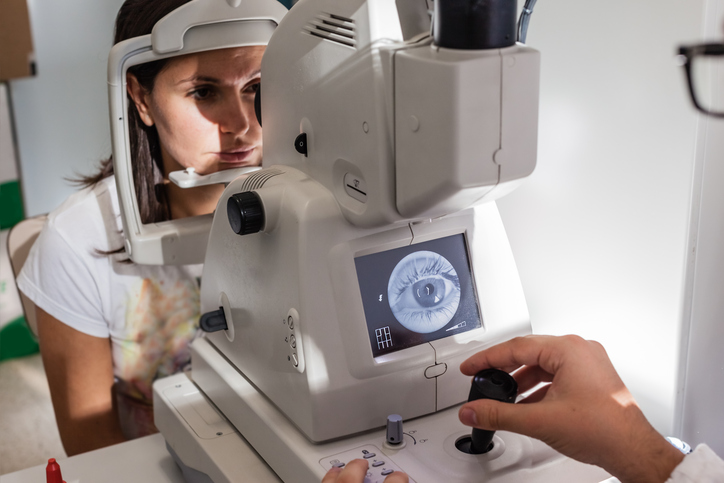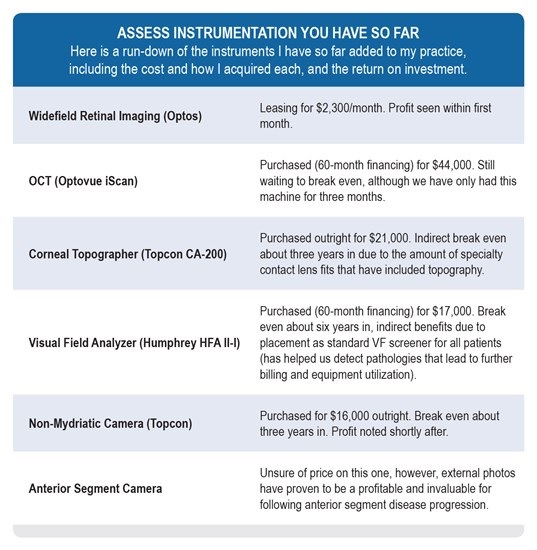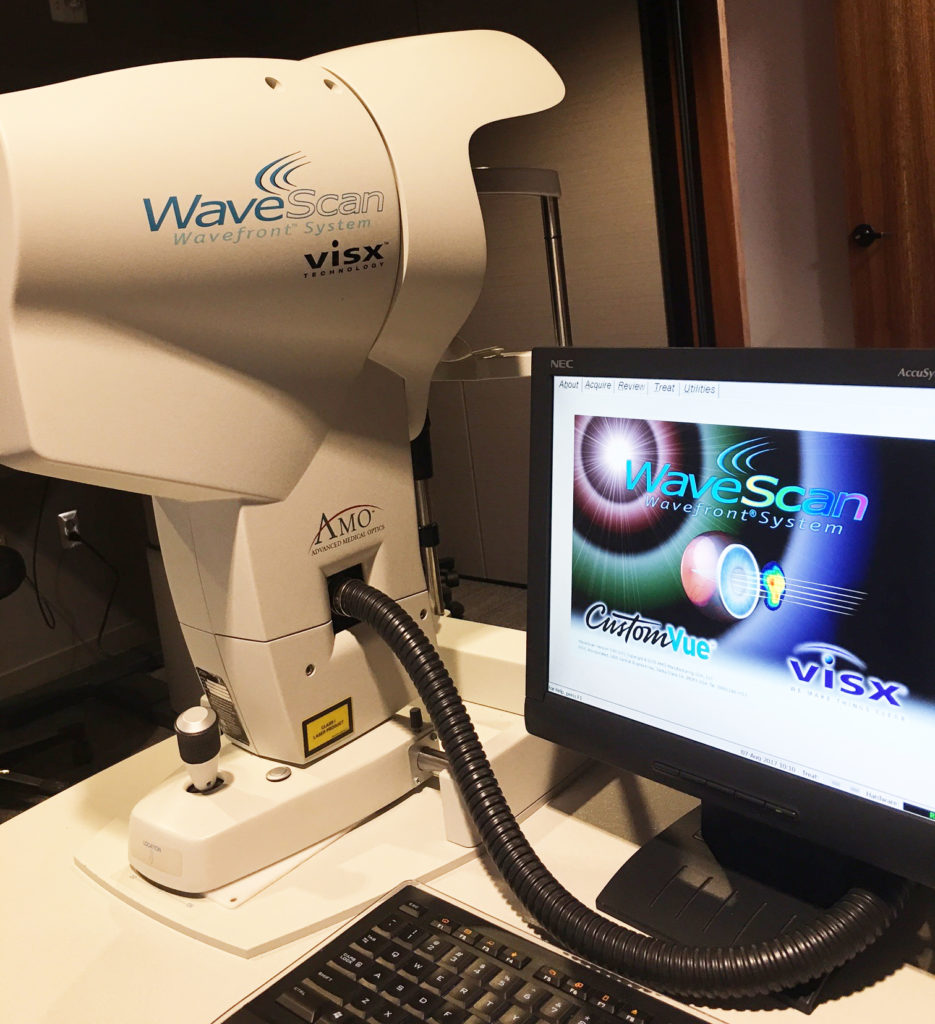By Suzanne LaKamp, OD, FAAO

August 23, 2017
Having the latest diagnostic instrumentation improves your ability to serve patients. It also can be a practice- and profitability-builder, enabling you to see additional patients per day and to more readily diagnose eye disease.
But to realize those benefits fully, both doctors and support staff must be fully trained to use the equipment to the highest level.
Doctors need to be trained on when to order the test, and how to read the test results, whereas staff needs to be trained on how to run the test.
I am fortunate to be an associate at a shared OD-MD practice that has the best available technology. Older equipment is continually switched out for the new and improved.
Editor’s Note: MBA data suggests that 1-2 percent of gross revenue should be budgeted for clinical instrumentation per year. ROI analysis calculations should determine which instruments to take on. Loan versus lease considerations come into play with cash-flow analysis, and by analyzing the long-term viability of each instrument.
It is important to consider whether the updated technology warrants additional cost. Each practice has unique needs for equipment, and budgets will vary. A dry eye clinic/corneal specialist requires different imaging and equipment than a pediatrics practice.
Costs in technology reduce the longer equipment is on the market. The LipiView activator costs, for example, have come down significantly over the last few years. Reduction in activator costs made the procedure more affordable for patients, which in turn, helps practices in terms of patient volume and profit.
Our exam rooms include equipment such as a biomicroscope, phoropter, digital acuity chart, computer and another laptop for the scribe.

Instrumentation costs and ROI at the practice of another ROB contributor, Aaron Neufeld, OD. Click HERE or the image above to read how Dr. Neufeld plans his instrumentation purchases to ensure they deliver good patient care and revenues.
We have designated testing rooms for more in-depth imaging and analysis. Our other equipment includes: slit-lamp cameras ($4,000 each), pentacam topographer ($50,000), fundus camera with OCT ($50,000), Visante OCT, HD analyzer, LipiView II ($40,000), LipiFlow ($25,000), AMO Visx Wavescan ($7,000), WaveLight Topolyzer VARIO and the ZEISS IOL Master ($24,000).
A staff that is not well trained to use instrumentation can disrupt your work and patient flow. When trained well, the instruments can be used to reduce chair time. In our office, technicians spend significant time training prior to seeing patients in clinic. The LipiView II is now taken for all patients in the clinic, and the technicians are now quick with this imaging, which helps facilitate discussion for dry eye patients. Doctors can now spend less time explaining dry eye, thanks to help from the images produced by the LipiView. Patients grasp faster why the doctor has diagnosed them with this condition, decreasing chair time.

The Visx WaveScan system in Dr. LaKamp’s practice. Training on this instrument, and others, says Dr. LaKamp, ensures efficiency and optimization that improves patient care.
Optimize Vendor-Provided Training and Support
The first step to getting fully trained to use instrumentation is taking advantage of the complimentary training provided by the vendor, and then, if necessary, seeing how that training could be supplemented.
The complimentary training offered by vendors varies greatly in quality and quantity. Sometimes training consists of one session, and for more complex equipment, it may consist of multiple sessions over a half-day with multiple trainers. Training should include equipment use, data interpretation and troubleshooting. Clinic schedules in our office are blocked during training sessions.
The ODs at my current practice recently completed online training and clinical practice for the WaveLight Topolyzer VARIO with three vendor representatives. The practice currently uses the VARIO for iris registration and cyclotorsion control during WaveLight refractive LASIK. We will expand upon our previous knowledge, and complete more upcoming training for Contoura topography-guided LASIK. The representative training sessions are key for proper equipment use, interpreting good data and efficiency.
When working on certification for the Visx WaveScan, a representative trained me, and then had me complete many scans on my co-workers. The representative would then ask questions regarding the scans and results as a way to further enhance learning. The feedback was helpful, especially before using the instrumentation on patients.
Ensure Instrumentation is Set for Accurate Data Interpretation
For more complex technology, industry representatives and engineers should be at the practice when new equipment is installed. Extensive testing of the machinery may be necessary, and in some cases, equipment has to be re-calibrated. Industry reps also guide the OD and staff on data interpretation. Daily calibration for some machines helps to ensure that the data collection is good.
Cross-Train on Instrumentation
Our office does not have one group of trainers. Rather, there is a great deal of cross-training. For routine imaging, such as pentacams, the technicians have more experience, and usually train the newer technicians. The ODs are capable of taking most imaging in the office, and can also help train the support staff. The ODs, however, typically only operate the VARIO and other more advanced instrumentation themselves.
Get Perspective from Other OD Users of Instrument
A doctor first learns about new instrumentation at conferences, from lecture or the exhibit hall, and through professional journals.
Conferences facilitate collaboration among professionals about instrumentation best practices. Sharing contact information with other doctors at industry events can help you understand how to best integrate and use the equipment you purchase. I have exchanged e-mails with doctors outside my practice to discuss the benefits and disadvantages of certain instruments. A doctor with real-life experience can provide the clinical and business perspective that a trainer may not know. The manufacturer trainers are usually biased toward the advantages of equipment.
Continuing education is a great way to stay current with the use of new instrumentation, and how it applies to patient care. The Vision Expo conferences have numerous courses on instrumentation, how it enhances patient care, and how to incorporate new products in a business. A course I recently took through Vision Expo, “The Greatest Anterior Segment Disease and Medical Management of Contact Lens Complications Course – Ever,” provides information about anterior segment tools, such as the BlephEx for blepharitis.
Do Trial Runs Before Using on Patients
After our doctors and support staff have been fully trained on the instrumentation, we sometimes will try it out on each other before using it to test patients. Doing this gives us a sense of how it feels to use the instrument on another person, including instructions that might need to be given to the person being tested on how to position themselves in front of the instrument, what should be explained to them, and how easy it is to capture the needed image or information.
Use Job Aids (aka Cheat Sheets)
Most of the instruments in our office have visual aids or printed instructions about powering the equipment up and down, saving and exporting files, and how best to instruct patients being tested. We also have user guides for more detailed instructions, or troubleshooting information.
Take advantage of the online, or printed, materials your vendor provides you with, and make it readily available to staff. For instance, you could print out the instructions, or visual prompts, and affix it to the wall next to where the technician sits, so they don’t have to take time looking up the information online, or in a print manual, when struggling to capture the needed image.
 Suzanne LaKamp, OD, FAAO, is an associate at Durrie Vision in Overland Park, Kan. To contact: dr.suzanne.lakamp@gmail.com
Suzanne LaKamp, OD, FAAO, is an associate at Durrie Vision in Overland Park, Kan. To contact: dr.suzanne.lakamp@gmail.com





















